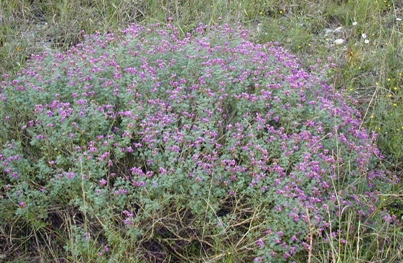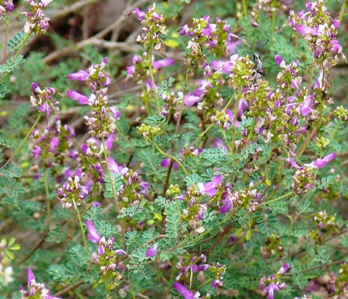Our prolonged drought and brutal heat wave have just about worn down my enthusiasm for writing about native plants in the garden. Even long-established native plants are suffering, while it is getting more and more necessary to forgo irrigation throughout much of the Hill Country, because most of the aquifers are providing less and less water.

Luckily for me, the plant-of-the-month committee of Operation NICE! (Natives Instead of the Common Exotics!) has picked a local native that I can feel good about, even now. The September plant of the month is black dalea (Dalea frutescens), a highly drought-resistant little shrub with small purple and white flowers. It is one of the plants still green in our backyard.
Black dalea is a low airy shrub, commonly forming mounds a few feet wide and a couple of feet high. Its small leaves are pinnately compound, usually with 13-17 tiny leaflets on each leaf. The bloom period is from mid summer to mid fall. Last year ours was in full bloom during September. Clusters of purple and white flowers are born on short stalks toward the ends of the branches. Individual flowers are only about half an inch long, but the blooms may be dense. In full flower, the black dalea is an eye-catcher.
Some small clumps of black dalea were planted by a good friend of mine who loves native plants, but doesn’t particularly enjoy gardening. She stuck the daleas on a rocky slope behind her house and didn’t give them much more attention. I would guess they never were watered after they were first planted. Now those little clumps have grown into large mounds that are spectacular during the blooming season. This plant of the month is pretty tough.
Black dalea seems to do just fine in open sun and in well-drained calcareous soil without a lot of watering and fertilization. The Boerne Chapter of the Native Plant Society of Texas provides free planting and care instructions for black dalea at nurseries participating in Operation NICE! (Hill Country African Violets & Nursery and Maldonado Landscape & Nursery) and at Cibolo Nature Center. Probably it wouldn’t be advisable to put any new plants in the ground before late September or October or whenever this heat lets up.

In Texas there are at least 39 species of Dalea, most of which grow in dry parts of the state. The black dalea grows from southeastern Oklahoma through central North Texas, around the eastern and southern parts of the Edwards Plateau, through the Trans-Pecos, and across northeastern Mexico.
Kendall County is one of the places it has been collected by botanists, but so far I haven’t been able to find it in the wild. Chuck Janzow saw black dalea on the I-10 right-of-way in Boerne some years past, and Jan Wrede and Kim Kuebel spotted it on Highway 46 in western Kendall County many years ago. It is not common around here.
Jan Wrede writes that black dalea has been removed from much of its former range by cattle browsing (“Trees, Shrubs, and Vines of the Texas Hill Country”). The severe overpopulation of deer probably will lead to its elimination in many areas of the Hill Country. Reportedly, black dalea survives where it grows within the protection of sticky agarita branches in parts of Kerr County. If you find black dalea in the wild, it is worth protecting.
